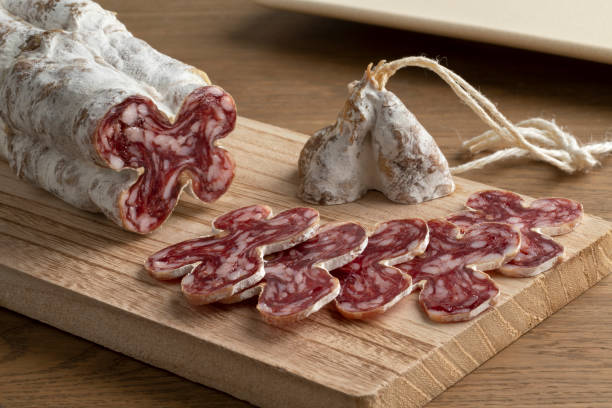The name “saucisson” is derived from the French word "dry sausage." Wild sanglier (boar) and taureau (beef) varieties of this French delicacy can be found if you seek care. The French prefer leaner, tougher pork cuts such as leg or shank meat, with fatback or belly meat to fill in the gaps. The saucisson farce is seasoned with salt, sugar, regional spices, and sometimes garlic after it has been crushed together. After that, the finished product is packed inside a natural hog casing, though I've also seen a tiny diameter beef bung used. Lactobacillus, our bacterial friend, is the distinguishing feature. The saucisson has a delicate chew and a white, sticky surface due to fermentation. The meat is then dried to the proper texture by hanging it from the ceiling of a local butcher shop. When sliced, the majority of them are moist but firm, whilst others are bone dry and brittle.
In the north, where saucisson remains untouched, the meat's quality speaks for itself. When you reach the south of France, all bets are off. There are nearly as many saucisson kinds and additives as there are cheeses, whether at the ubiquitous market day stall or the more Walmart-style Carrefour hypermarket.
Where saucisson sec comes from?
Since the Roman Empire, when France was known as "La Gaule," saucisson has been made in France. Recipes and techniques for saucisson were discovered some 2000 years ago, during the reign of the Roman Empire. The Romans became so enamored by French pork that they began producing their own cured meats across the country. The saucisson's origins may undoubtedly be traced back to this period in history. Approximately 110,000 tons of saucisson sec are consumed in France each year.
Stuffing
The filler for saucisson is normally two-thirds to three-quarters lean beef and the rest fat (mostly bardière, or hogback fat). Depending on the type of saucisson, the combination is ground to a finer consistency and mixed with sugar, salt, fermenting microorganisms, saltpeter and/or nitrites, as well as spices. Lactobacillus sakei strains, for example, are used in Europe to make saucisson and can also be used to keep fresh meat fresh. Roquefort, garlic, bits of nuts or dried fruits (such figs, French pistachios, or olives), mushrooms, Pepper seeds, Laguiole, or Génépi liquor or wines are all common saucisson components.
In France, saucisson is available in many different flavors. Depending on the type of meat used and the manufacturing procedure, saucissons come in various shapes and sizes. Each area developed its flavoring notions based on what was available locally in terms of nuts, herbs, and other resources. Throughout the years, each of these saucissons has been painstakingly prepared! All of these variations have one thing in common: the capacity to settle your stomach and, in many cases, the ability to pair well with a bottle of wine and a cheese plater.
Why do the French love saucisson so much?
To the rest of the world, France is known for its cheese and wine, but the Gallic love for cured, saucisson, or salty pork sticks, is just as timeless and strong. Of course, France is an ideal location for a Saucisson World Cup, as the country eats 2.2 kilograms of saucisson every second, amounting to 70,000 tonnes annually. So, why does saucisson elicit such a visceral response in the taste buds and hearts of French people of all generations?
Saucisson is a way of life in France, not merely a variety of pig. It is the national emblem of France. Every family will have some, similar to baguette and cheese. Saucisson's appeal is due to its close relationship with aperitifs (appetizer). When friends come together for a drink and some nibbles at the end of the day to unwind and catch up, they like to eat saucisson. A decent glass of wine and a piece of saucisson are an unbeatable combination.
Saucisson Sec-The Ultimate Dry Sausage
The flavor and texture of saucisson sec are far more mellow, rich, and fragrant than that of any other hard salami. The flavor is rich and wonderful, even if some saucisson sec has a robust, almost harsh texture. Saucisson sec is thinly sliced and has a wafer-like consistency, yet it has a rich flavor that will have you wanting more. Saucisson sec gets its characteristic flavor from garlic, pepper, natural sea salt, and a variety of other spices.
Because of the little pebbling present, the saucisson sec has an almost creamy texture. The distinct beef flavor of Saucisson sec distinguishes it from other salami and dry sausages. Saucisson sec has a creamy, robust, and rich flavor that appeals to a wide range of palates. Saucisson sec is traditionally produced using a mild-flavored pig, although it can also be made with boar, duck, deer, or even geese.
Distinct Recipe of Saucisson
Saucisson sec is made in secret by every French household and charcuterie establishment. Regardless of how you slice it, the majority are organically air dried, full-flavored, and delicious. The rich meaty texture and flavor, prepared in a centuries-old French tradition, are appealing whether you slice it and eat it on crusty toast or simply on its own to appreciate the subtle garlic and thyme flavor.
What could be more delicious or attractive than saucisson on a finely sliced fresh French baguette? For a delectable appetizer, serve with mild mustard or luscious truffle butter. Salami has a sweet, but slightly tart, flavor. It has a fatty flavor that is unattractive when ingested on its own. It has a rough interior with huge bits of meat and fat mixed in. Saucisson can be eaten by the slice, making it ideal finger food, or used to season crackers, toast, and a variety of other dishes.
Saucisson sec as an ingredient
Saucisson sec, on the other hand, can be used for a lot more. Saucisson sec may add a meaty, nuanced, and flavorful flavor to other meals. Saucisson sec is normally served cold, but it can also be served warm with creamy cheese broiled on top over crusty toast. Typically, saucisson sec is added to soups and stews by the French to give a hearty stew or chicken dish a distinctive flavor. For something completely different, combine the tastes of saucisson sec with smoked turkey and lettuce on a wafer-thin onion sandwich.
Simply irresistible
Even vegetarians admit to occasionally craving the salty, flavorful body of cured ham. Saucisson de France is a universe unto itself, developed over decades with affection." Each region evolved its unique spices depending on the plants, nuts, and other ingredients available locally," says Dusoulier. Regardless of the type, all saucissons have one thing in common: the capacity to calm even the most growling tummies, satisfy our protein needs, and, in many cases, be the perfect match for a beautiful bottle of wine.

3 Most Popular French Sausages and Salamis
- - Saucisson de Lacaune
Saucisse de Lacaune and saucisson de Lacaune are meat products made from pig or wild boar. The only difference is that one is a sausage and the other is salami. The Tarn region of France produces them. The sausages are dried and packaged in natural intestines, and they can be coiled, straight, or twisted around a pole (to dry better). They have a firm but supple texture, with lean red to dark red meat on the inside when sliced. These products have a flavor that is comparable to that of dried, aged beef, but with a strong peppery note and no greasiness. Salt, pepper, and nutmeg are sprinkled over the meat before drying. It pairs well with cheese in sandwiches.
- Saucisson de l'Ardèche
The Saucisson de l'Ardéche is a pig and fat sausage made in the Ardéche area of southern France. The traditional recipe calls for a mixture of matured and fresh meat to be minced, heat-treated, dried and packed in natural hog intestines. Sausages come in a variety of shapes, sizes, and weights, and are named for the section of the intestines where the meat is placed. The six types are Jésus, Petit Chaudin, Rosette, Gros Chaudin, Chaudin and Saucisse séche, with Gros Chaudin weighing more than 2 kg. The sausages are dark crimson, with a delicate and exquisite texture and a salty, spicy, meaty, and acidic flavor when cut. Salads, sandwiches, and hard cheeses are all wonderful with it.
Saucisse sec d'Auvergne is a thick, dry-cured sausage from Auvergne, a central French region known for its agricultural, farming, and meat curing traditions. Unlike saucisson sec d'Auvergne, which is made wholly of pork or a blend of pork and beef, this sausage is made entirely of sow meat. The famed sausages of Auvergne are all handcrafted and cured for two months. They're frequently served with handmade bread and a slice of Brie and coarsely chopped into thick slices.
How to cook
If you're new to charcuterie, this classic French sausage is an excellent place to start. The procedure is simple, the spices are simple, and the curing may be done in a somewhat forgiving environment, such as a garage or basement, without the use of specialized equipment.
Cured salt: As with all cured meats, some specialist ingredients are used, such as casings, curing salt (also known as Prague powder or Insta Cure), and dextrose. Curing salt contains sodium nitrate and sodium nitrite, which inhibit the growth of microorganisms that cause botulism and are thus required for the dish's safety.
A stand mixer fitted with a meat grinder attachment is all that's required for this recipe. Keep everything cold at all times. The meat should always be cold enough to cause pain in your hands if you handle it for an extended time. If things start to warm up, place them in the coldest part of the fridge or even the freezer for a few minutes, then do it again. As the sausage hangs, the flesh begins to ferment. White mold will appear on the exterior of the case. This is acceptable and desired in equal measure. After around 3 weeks, you should have a substantial salami-like sausage with a sour tang from the fermentation and balanced flavor. Serve with crisp French baguette and cornichon pickles. With a strong Dijon mustard, it's also delectable.
Ingredients
- 4 1/2 pounds (2 kilograms) pork meat
- 1/2 pound (225 grams) fatback
- 1 1/2 ounces (40 grams) kosher salt
- 1/4 to 1/2 ounce (10 grams) coarsely ground black pepper
- 1/2 ounce (15 grams) dextrose
- 1/4 ounce (6 grams) curing salt no. 2
- 2/3 ounce (18 grams) garlic, minced to a paste
- 1/4 cup (59 milliliters) dry white wine
- 8 feet of hog casing, soaked in tepid water for 2 hours before use
Cooking instructions
- Get all of the ingredients together.
- Get your meat grinder ready to go. Toss pig flesh and fatback into a mixing basin with a large plate (3/4 inch/1.9 cm).
- Using a paddle or a spoon, combine all remaining ingredients.
- Keep the casing damp in a dish of water while working with it. Without tying the casing, slide it onto the funnel. Fill the stuffer halfway with the mixture and tuck it in.
- Begin to extrude the material. As the mixture pours out, return the casing to the nozzle and secure a knot.
- Extrude a 48-inch-long (1.3-meter) coil and knot it off.
- Use your fingers to crimp the sausages into 12-inch (30-cm) lengths. Twist the casing once in one direction, then the other between each sausage link. Rep the process until the coil is completely wrapped around itself.
- Using a sterile needle, poke any air pockets in the sausage once it has been cased. Prick four or five times with a fork for each sausage. Repeat the casing process with the remaining sausage to use it.
- Cure sausages at 60-75 degrees Fahrenheit for 18 to 20 days.
- Once cured, sausages can be kept in the refrigerator for up to 6 months.




